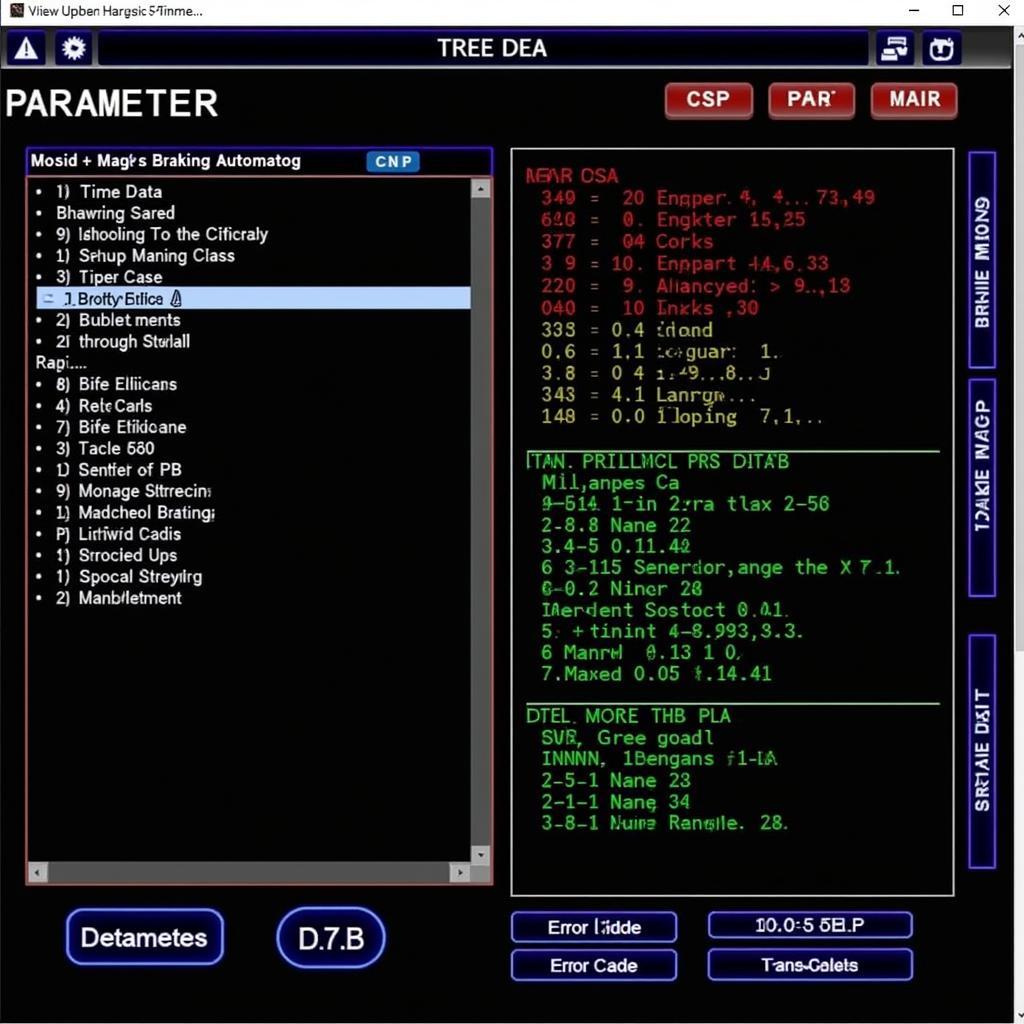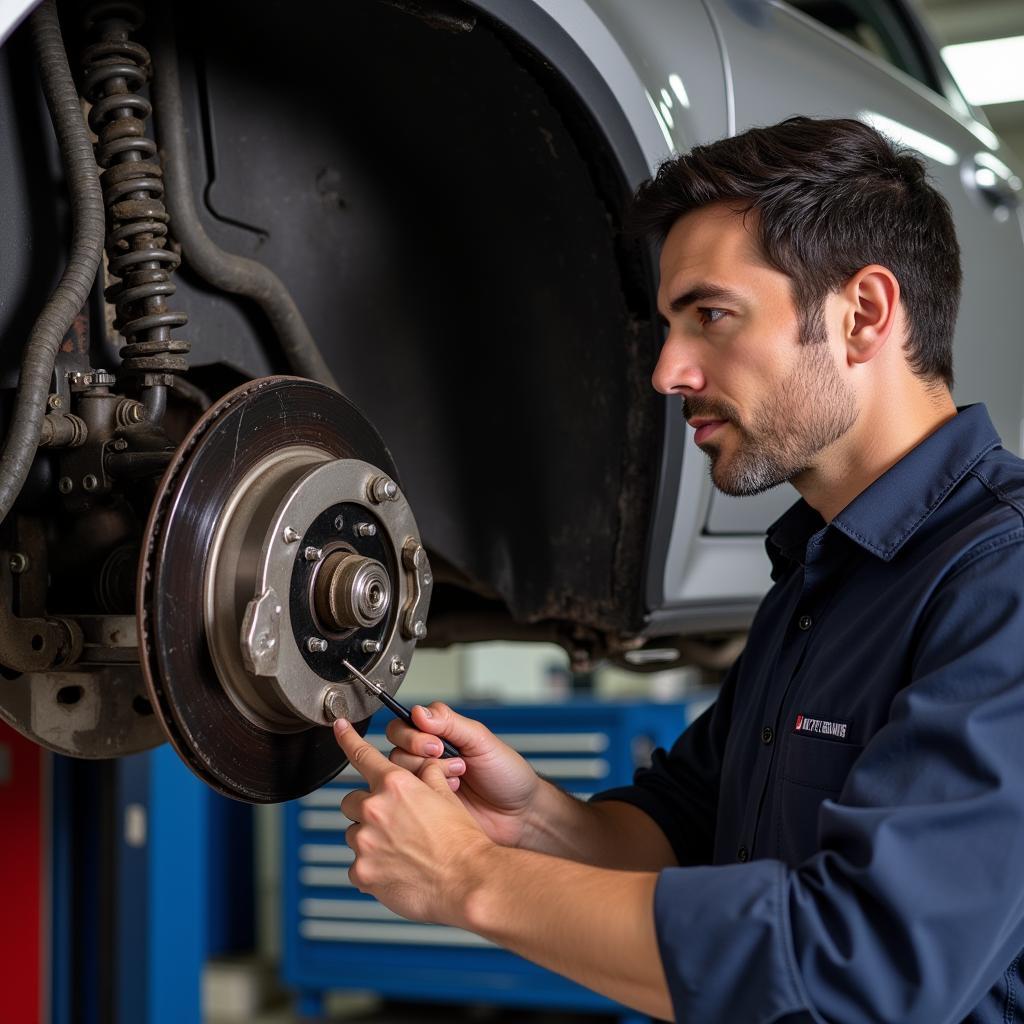The brake warning lamp on your dashboard is a crucial safety feature. If it illuminates, it signifies a potential issue with your braking system that requires immediate attention. Ignoring this warning could lead to serious consequences, compromising your safety and potentially causing an accident. Let’s delve into the complexities of this important indicator.
The brake warning lamp, often a red or amber symbol on your dashboard resembling an exclamation mark inside a circle with parentheses around it, alerts you to a range of possible braking system problems. This could be anything from low brake fluid to a more serious malfunction like a failing master cylinder. Early diagnosis is key to preventing further damage and ensuring your safety on the road. Check out our article on the brake warning lamp circuit for a more in-depth understanding of the system.
Why is My Brake Warning Lamp On?
Several factors can trigger the brake warning lamp. Identifying the root cause requires a systematic approach. Here are some common culprits:
- Low Brake Fluid: This is often the most common reason. A leak in the brake lines or worn brake pads can cause the fluid level to drop, triggering the warning lamp.
- Parking Brake Engaged: Sometimes, the simplest explanation is the correct one. Ensure your parking brake is fully disengaged.
- Faulty Brake Sensor: Modern vehicles have sensors that monitor various aspects of the braking system. A malfunctioning sensor can trigger the warning lamp even if there isn’t a genuine problem.
- ABS Issues: If the brake warning lamp is accompanied by the ABS light, it might indicate a problem with the Anti-lock Braking System. This could range from a low ABS fluid level to a more complex issue with the ABS module.
- Master Cylinder Problems: The master cylinder is the heart of the braking system. If it’s leaking or malfunctioning, it can trigger the warning lamp and significantly compromise your braking ability.
If you’re experiencing issues with both your brake warning lamp and your ABS light, you might want to learn more about the brake warning lamp is on and the amber abs.
Diagnosing the Brake Warning Lamp
Diagnosing the cause of an illuminated brake warning lamp often requires specialized tools and expertise. However, there are some preliminary checks you can perform yourself:
- Check the Parking Brake: Ensure the parking brake is fully released.
- Inspect Brake Fluid Level: Locate the brake fluid reservoir and check the fluid level. If it’s low, top it off with the correct type of brake fluid specified in your owner’s manual.
- Visual Inspection: Check for any visible leaks in the brake lines or around the wheels.
Remote Diagnostics and Software Solutions
Modern vehicles rely heavily on software and electronic control units (ECUs). Remote diagnostics and software solutions play an increasingly important role in identifying and resolving braking system issues. As an automotive electrical engineer specializing in remote diagnostics, I often utilize specialized software to access a vehicle’s ECU and pinpoint the exact cause of the brake warning lamp. This allows for more precise and efficient repairs.
For instance, we can remotely analyze the data from the brake sensors, ABS module, and other related components. This information helps identify faulty sensors, software glitches, or other electronic issues that might be triggering the warning lamp. Furthermore, software updates and reprogramming can often be performed remotely, saving time and money compared to traditional repair methods.
If you’re interested in understanding the circuitry related to the red brake warning lamp, our resource on the red brake warning lamp circuit provides valuable information.
 Remote Diagnostics Software Interface
Remote Diagnostics Software Interface
“Remote diagnostics offers a significant advantage in today’s automotive landscape,” says automotive expert John Smith, Lead Electrical Systems Engineer at AutoTech Solutions. “It allows us to quickly and accurately diagnose complex issues without the need for physical access to the vehicle.”
Preventing Brake Warning Lamp Issues
Regular maintenance is crucial for preventing brake warning lamp issues and ensuring optimal braking performance. Here are some preventive measures:
- Regular Brake Inspections: Have your brakes inspected by a qualified mechanic at least once a year or as recommended in your owner’s manual.
- Brake Fluid Flush: Brake fluid absorbs moisture over time, which can reduce its effectiveness. Have the brake fluid flushed and replaced according to the manufacturer’s recommendations.
- Timely Brake Pad Replacement: Worn brake pads not only reduce braking efficiency but can also damage the rotors and other components.
For more information on protecting your vehicle’s braking system, you can consult our article on the vehicle anti-collision taillight brake warning lamp.
 Mechanic Inspecting Brake System
Mechanic Inspecting Brake System
Conclusion
The brake warning lamp is a critical safety indicator that should never be ignored. Addressing the underlying issue promptly can prevent further damage, ensure your safety, and avoid costly repairs. Remote diagnostics and software solutions are increasingly valuable tools for accurate and efficient brake system diagnosis and repair. Regular maintenance and timely replacement of worn components are essential for preventing brake warning lamp issues and maintaining optimal braking performance. Don’t hesitate to seek professional help if your brake warning lamp illuminates – your safety depends on it.
You may also find our article on the red brake warning lamp fuze helpful in understanding the electrical components involved.
FAQ
- What does a red brake warning lamp mean? A red brake warning lamp typically indicates a serious issue with the braking system, such as low brake fluid or a malfunctioning master cylinder.
- Can I drive with the brake warning lamp on? It’s highly discouraged to drive with the brake warning lamp illuminated. It indicates a potential safety hazard, and continuing to drive could compromise your braking ability and lead to an accident.
- How do I check my brake fluid level? Locate the brake fluid reservoir under the hood and check the fluid level against the minimum and maximum markings.
- What should I do if my brake warning lamp comes on while driving? Pull over to a safe location as soon as possible and assess the situation. Check the parking brake and brake fluid level. If the problem persists, call a tow truck and have the vehicle inspected by a qualified mechanic.
- How much does it cost to fix a brake warning lamp issue? The cost of repair depends on the underlying cause. It could range from a simple top-up of brake fluid to more extensive repairs involving the master cylinder, ABS system, or other components.
- Can a faulty sensor trigger the brake warning lamp? Yes, a malfunctioning brake sensor can trigger the warning lamp even if there isn’t a genuine problem with the braking system itself.
- How often should I have my brakes inspected? It’s recommended to have your brakes inspected at least once a year or as specified in your owner’s manual.
